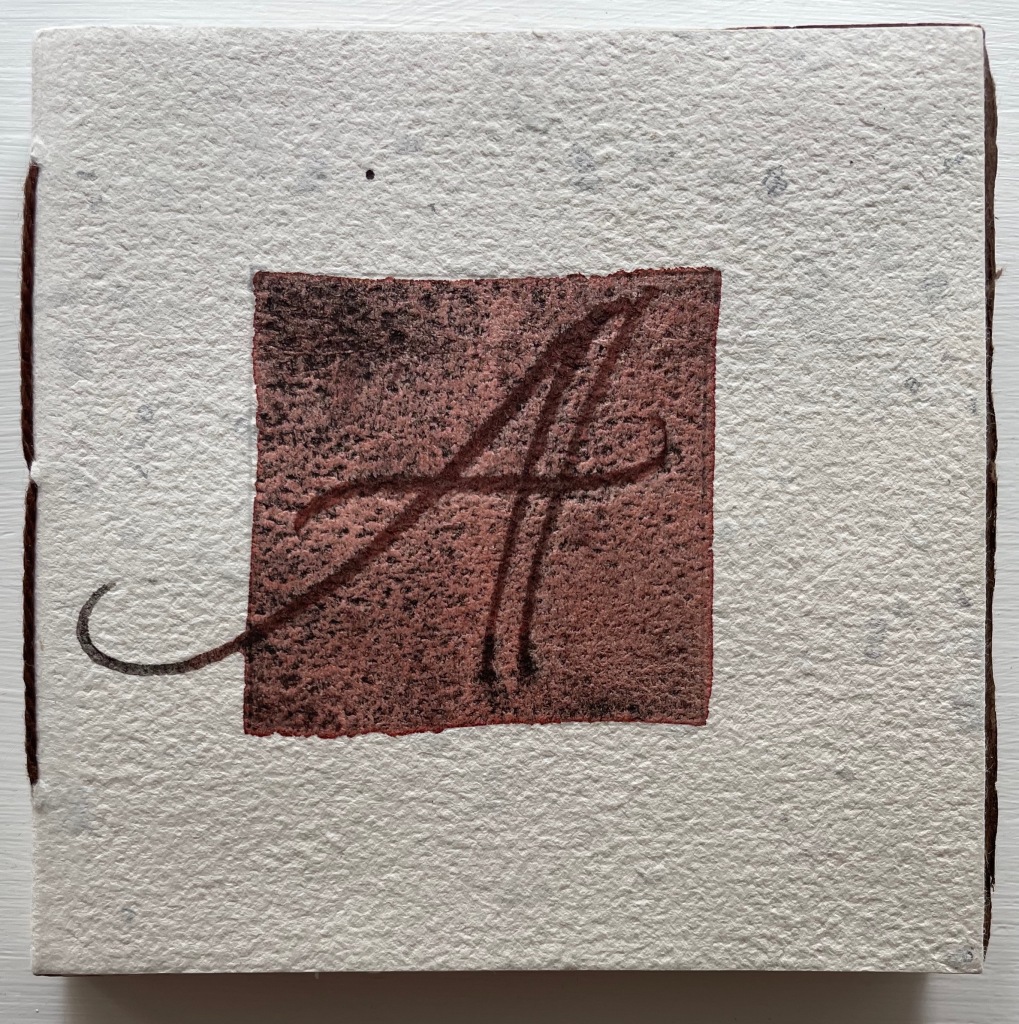Handscapes (2016)
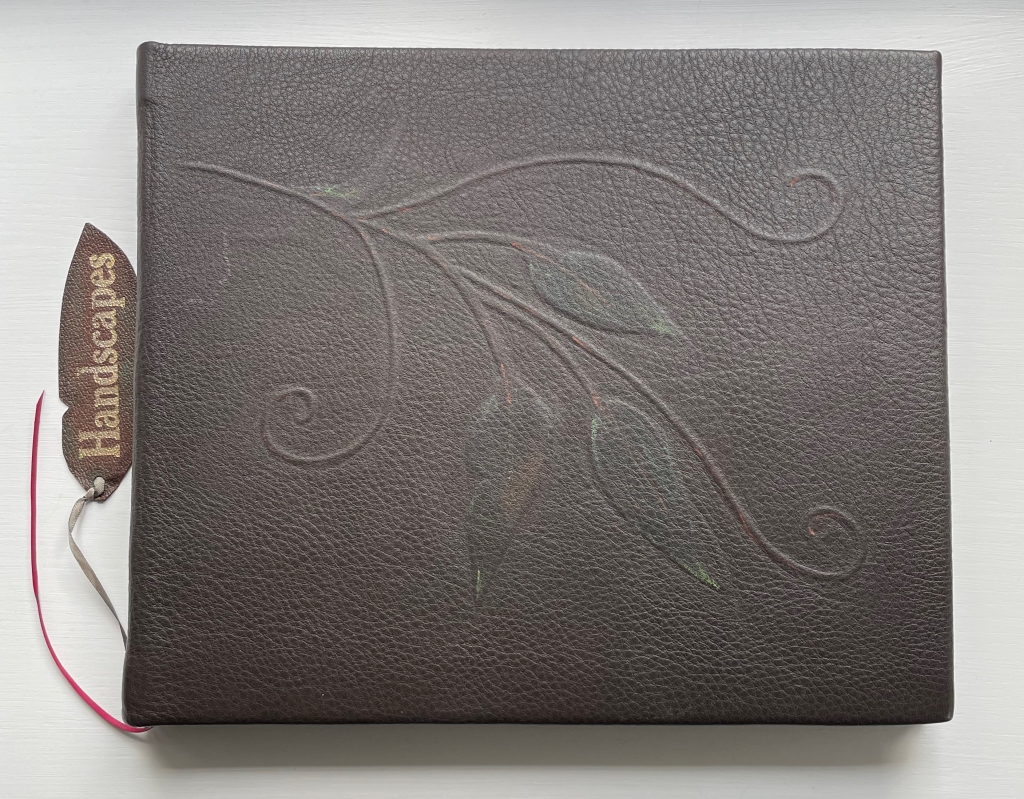
Handscapes (2016)
Margaret (Molly) Coy & Claire Bolton
Casebound, hand sewn and bound with doublures and two ribbon bookmarks. H260 x W310 x D30. 80 folios. Edition of 12, of which this is #9. Acquired from the artists, 19 October 2023.
Photos: Books On Books Collection. Displayed with artists’ permission.
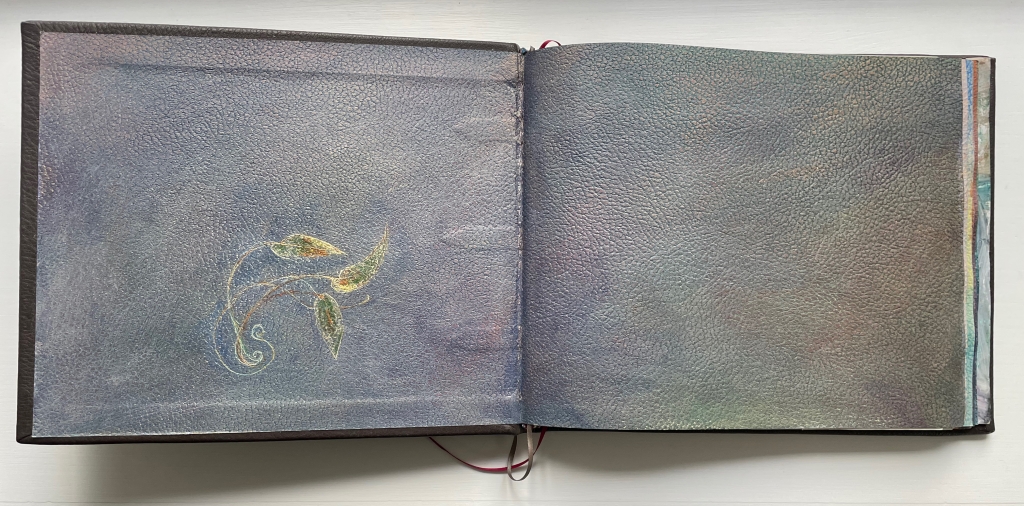
Like its title Handscapes, one half of the inspiration for this work of book art comes from the tools and material in the artists’ hands; the other, from Western Australia’s varied southwestern landscapes that the artists walked. Even its table of contents signals this dual inspiration with a single large wood type ampersand joining up each of the five section titles. The way the colors of ink move from dark to light and back across coasts & dunes, heath & ridge, thicket & forest, banks & brooks, caves & cliffs promises a rich journey for the eye. The shift from textured flyleaf to the Somerset paper of the contents promises the same for the hand.
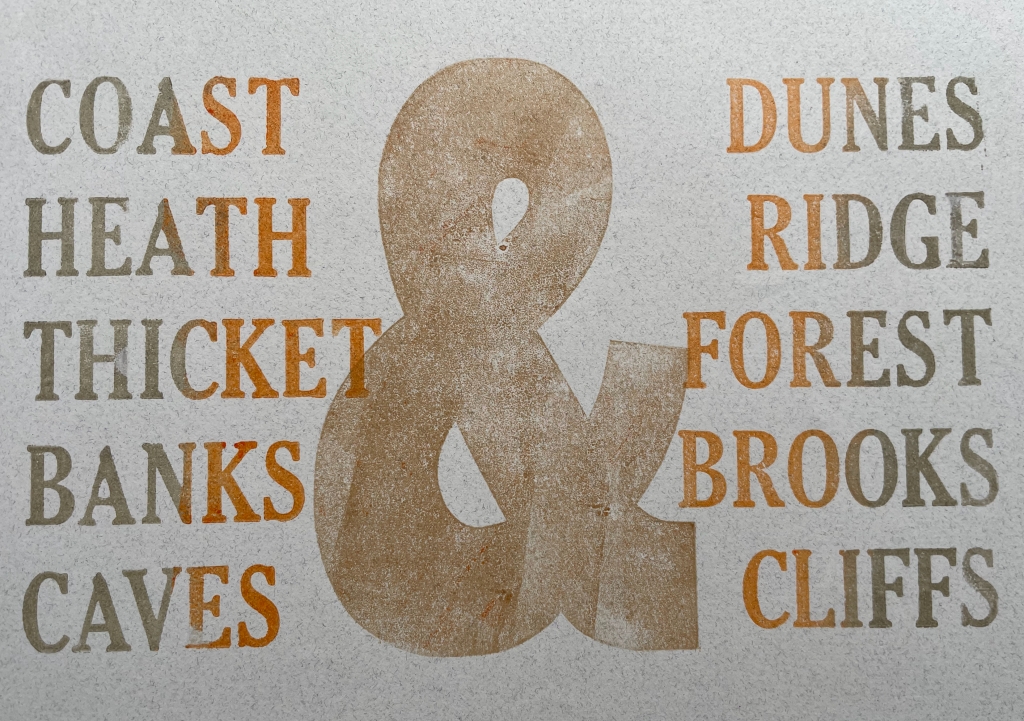
Hand-crafted from a variety of papers and printed using collagraph, etching, linocut, leaf prints, metal and wood type (both printed and blind embossed) and illustrated with watercolor, pencil and tinted wax, the sheets in landscape profile deliver on the offer made by the table of contents. The same textured paper used to open and close the book takes on different colors when it is used to open and close each of the sections. Perhaps it’s something to do with the change of colors from recto to verso, but somehow the feel of that leathery, elephant-hide-like paper seems to vary from section to section — sometimes rough, gritty, bristly or slick, sometimes warm or cool.

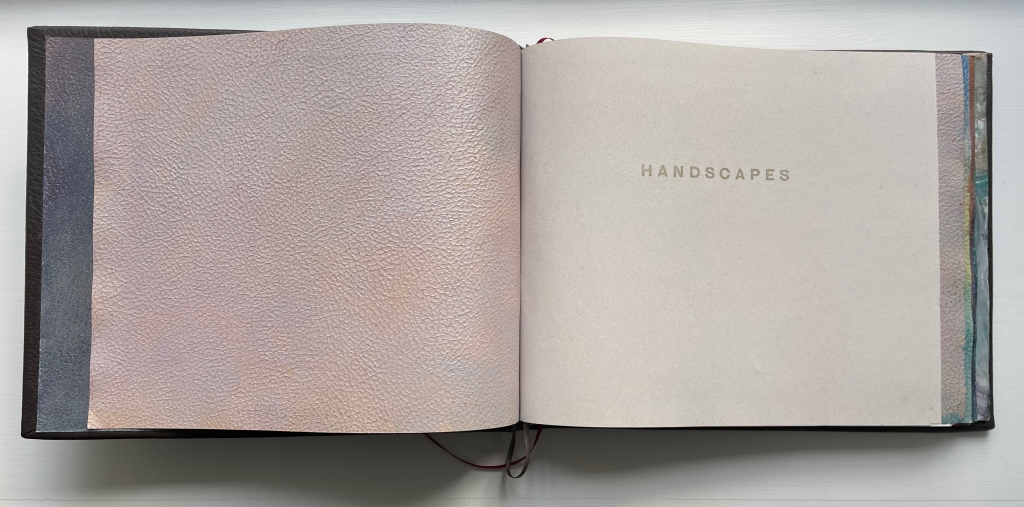
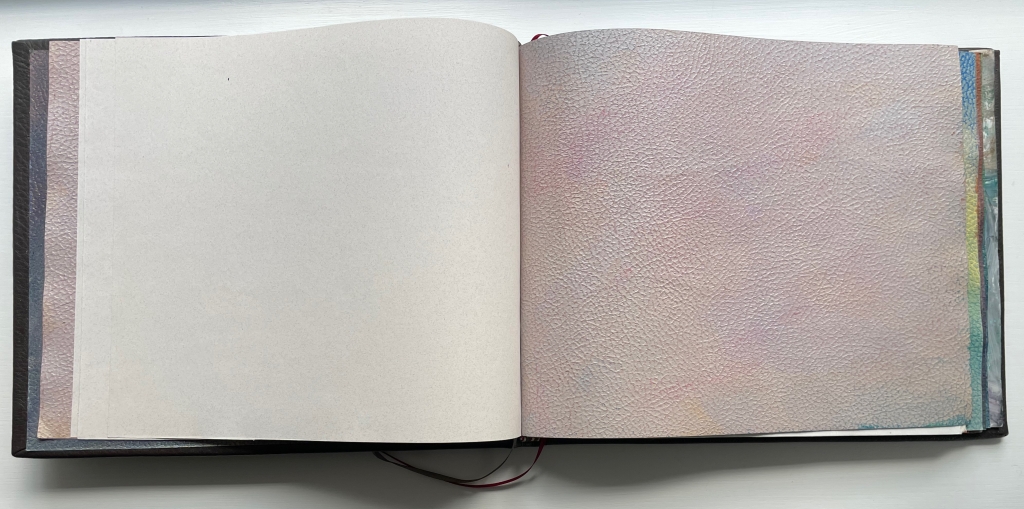
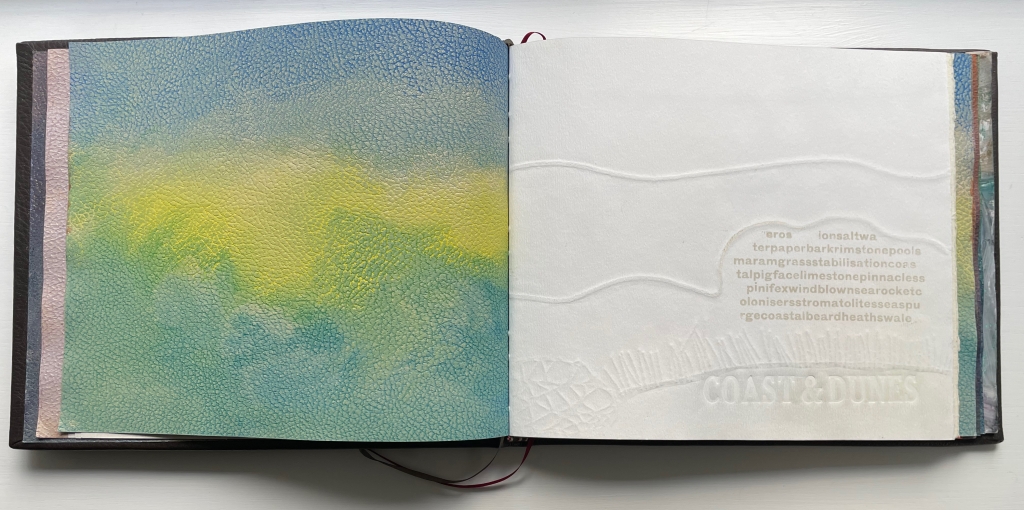

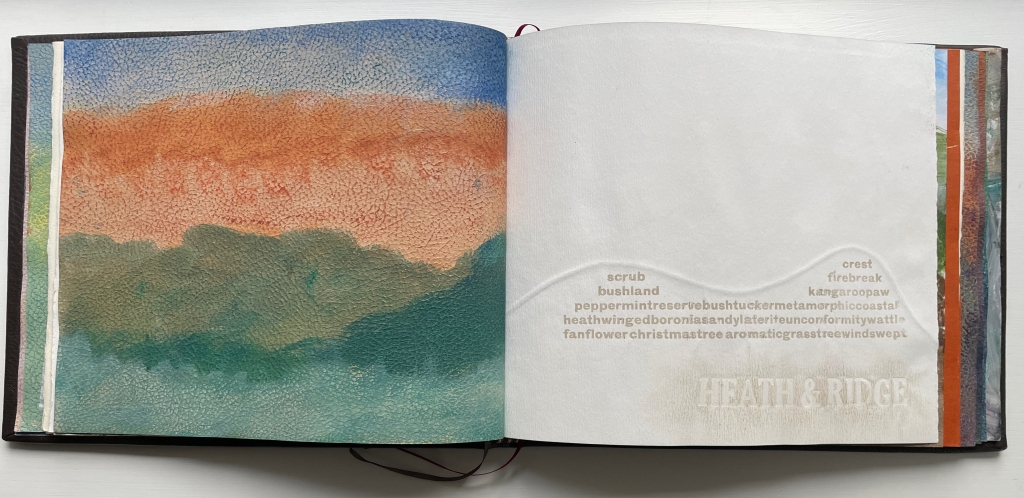
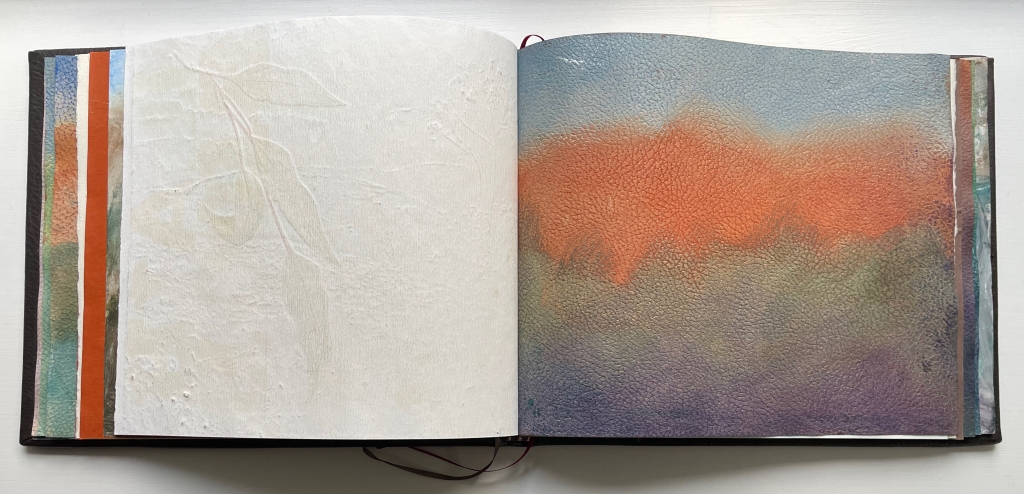

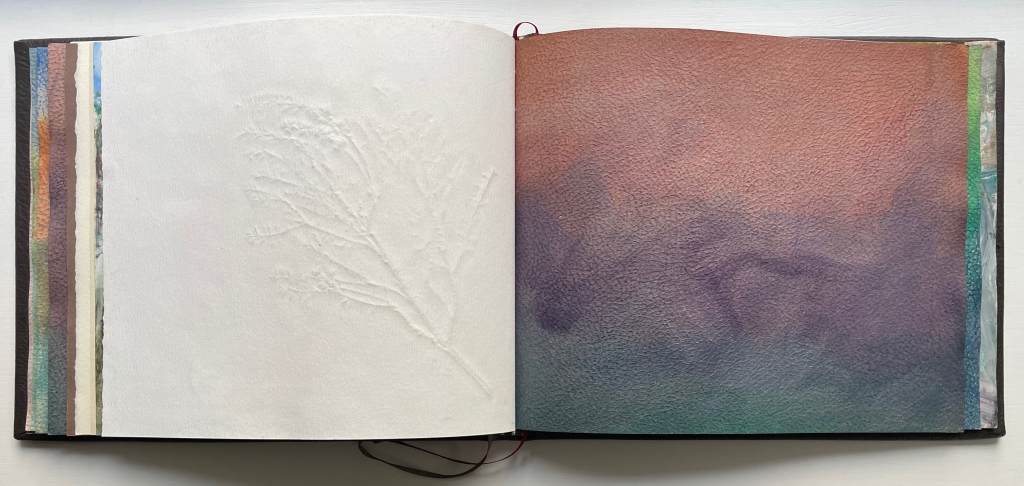
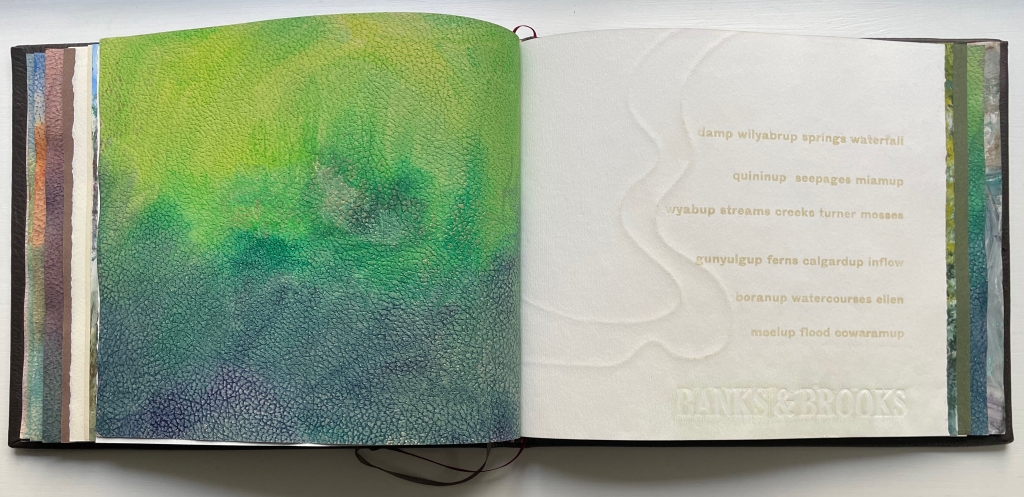

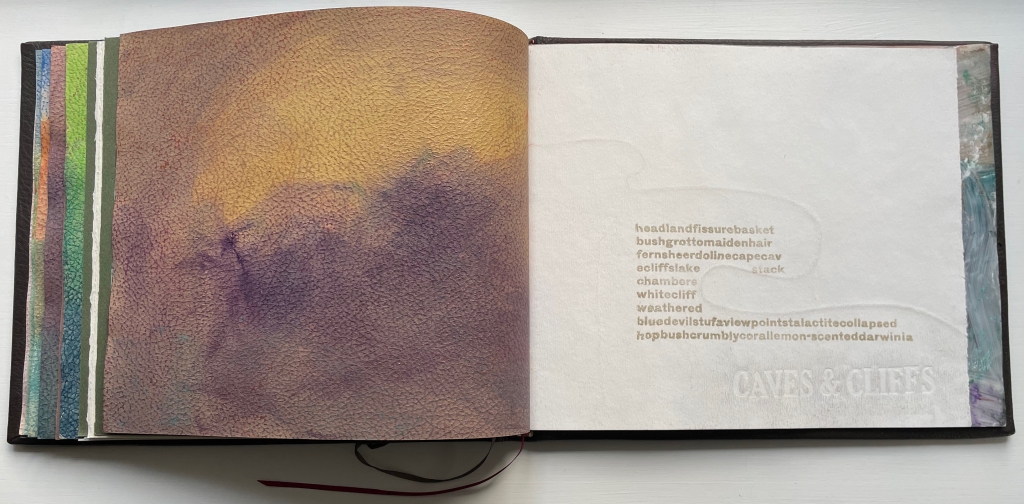

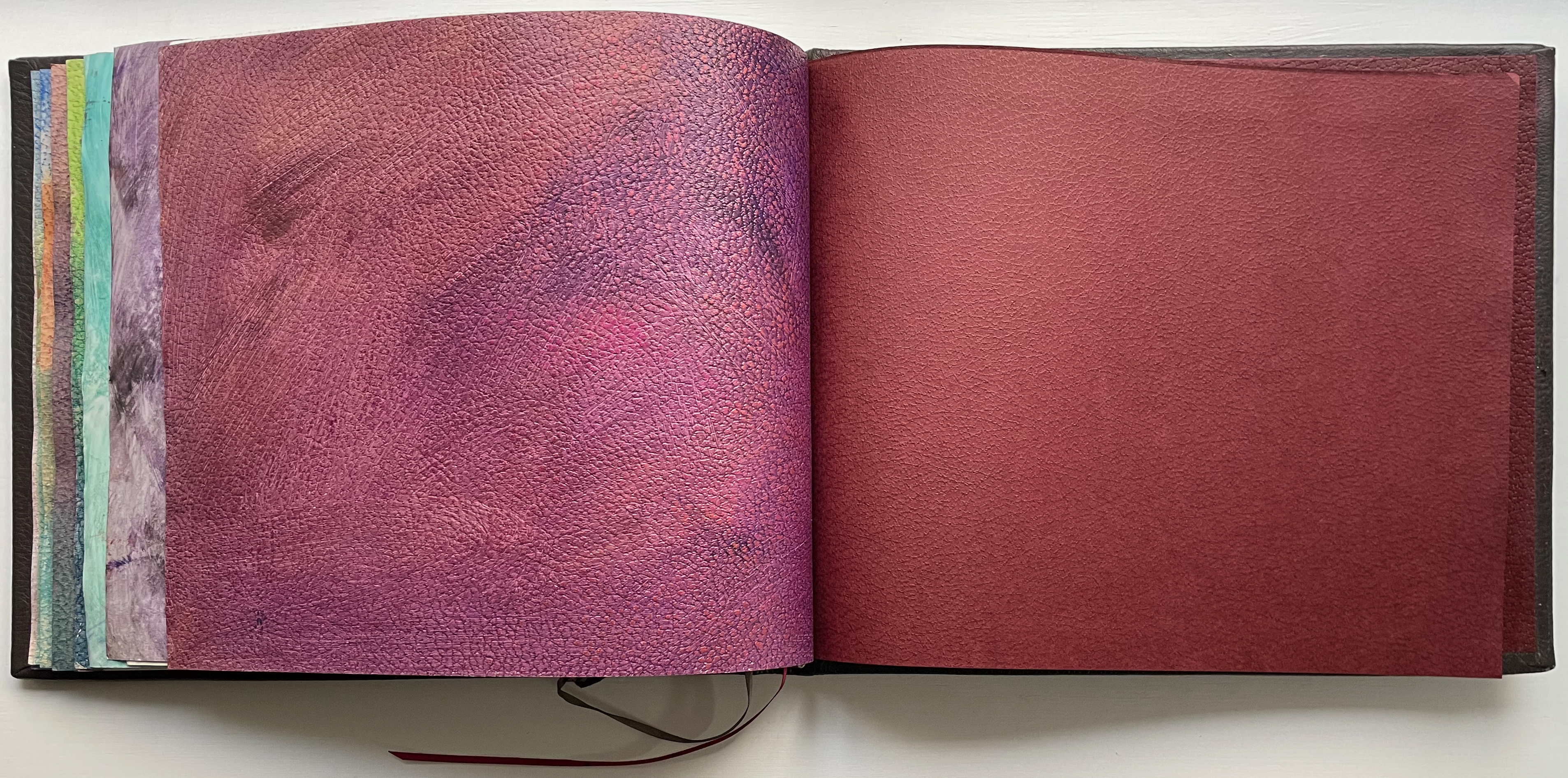
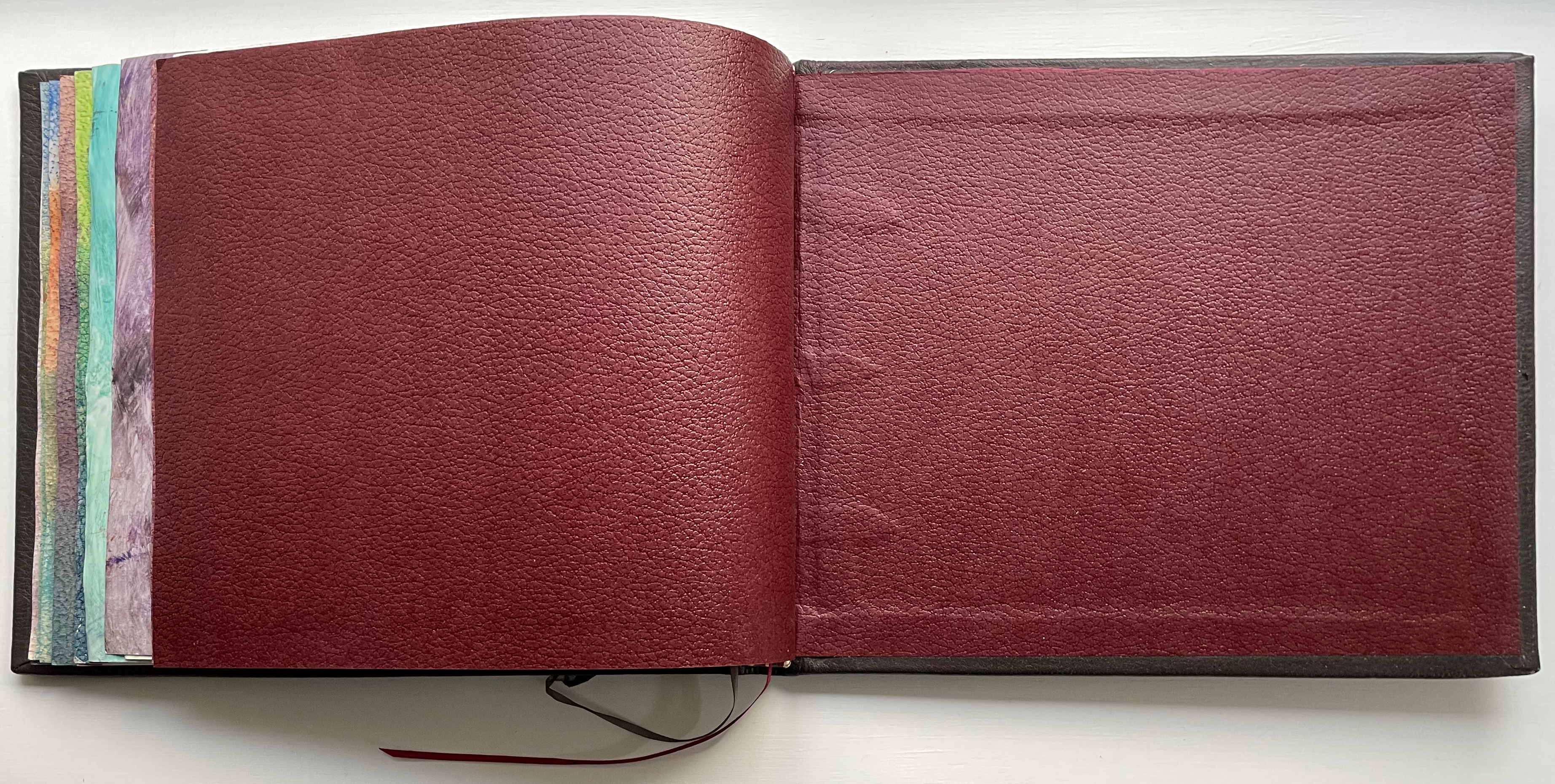
Each section’s opening recto page (above) relies on the text laid out like a concrete poem and playing with a blind debossed image to signal the landscape to follow, while completely different papers (below) give real shifts of touch in keeping with each change in landscape.


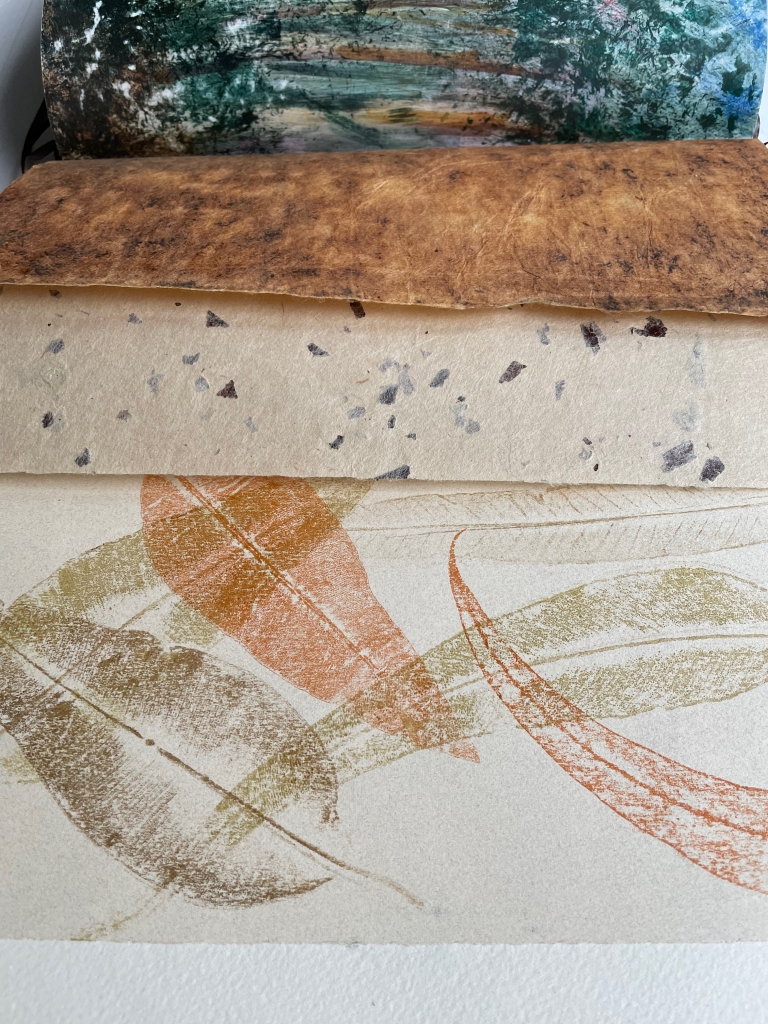
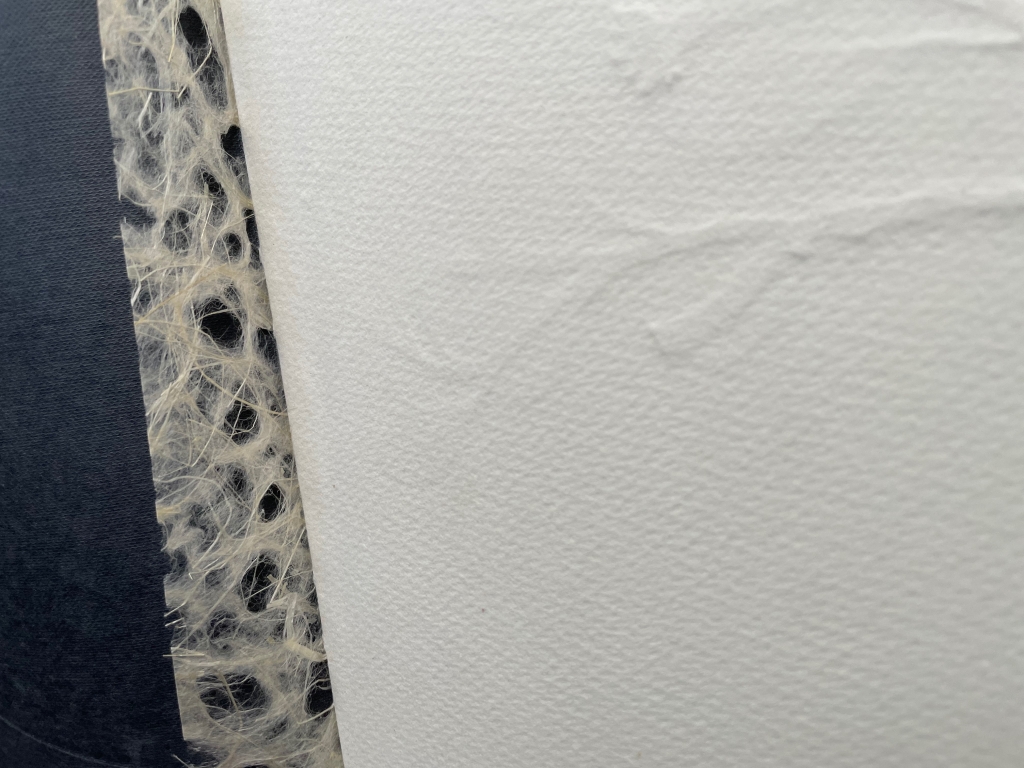
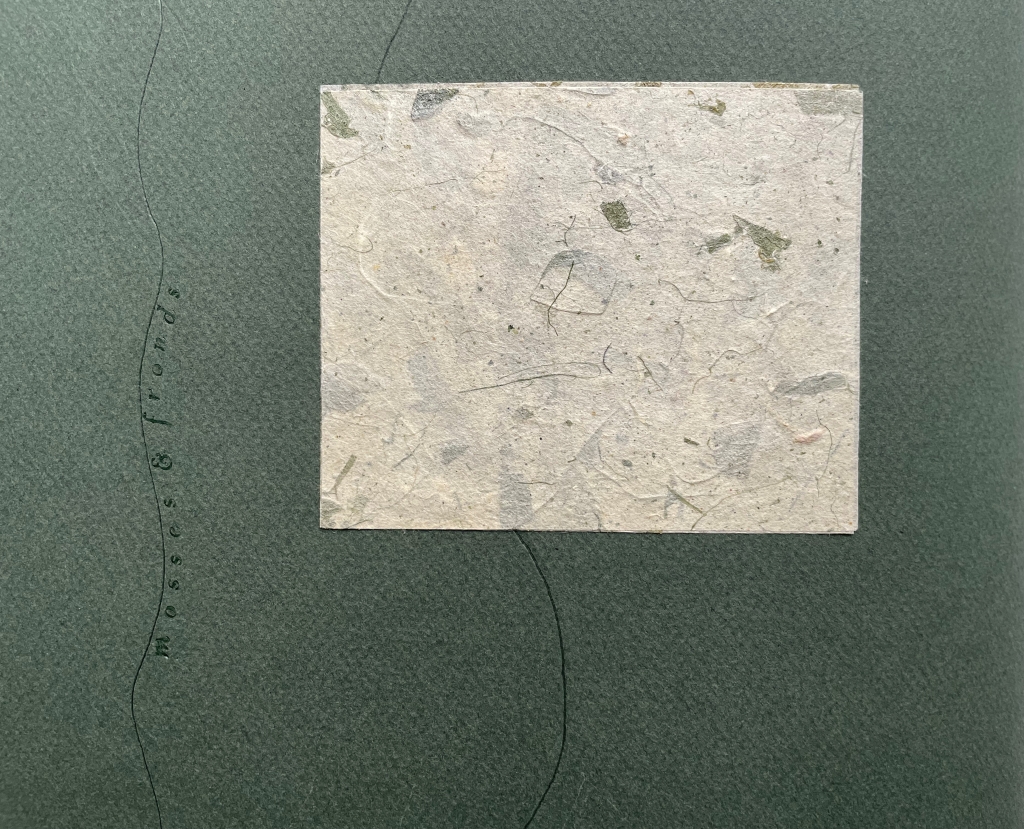
Clockwise: A foamy white cotton paper from “Coasts & Dunes”; a linen wove from “Heath & ridge”; several fibrous papers from “Thicket & Forest”; a vegetal paper from “Banks & Brooks”; and a loose weave so porous it mimics pumice from “Caves & Cliffs”.
Within each section, the pages also play off one another in ways that reflect the section’s landscape. Look at this sequence from “Coast & Dunes”. First comes a watercolor and acrylics with the colors of Sea Spurge (Euphorbia paralias) and Tucker Bush or Coastal Pigface (Carpobrotus virescens) and a painted, blind debossed print of Sea Spurge on the right — all in the foreground. In the distance, tide and strand meet.
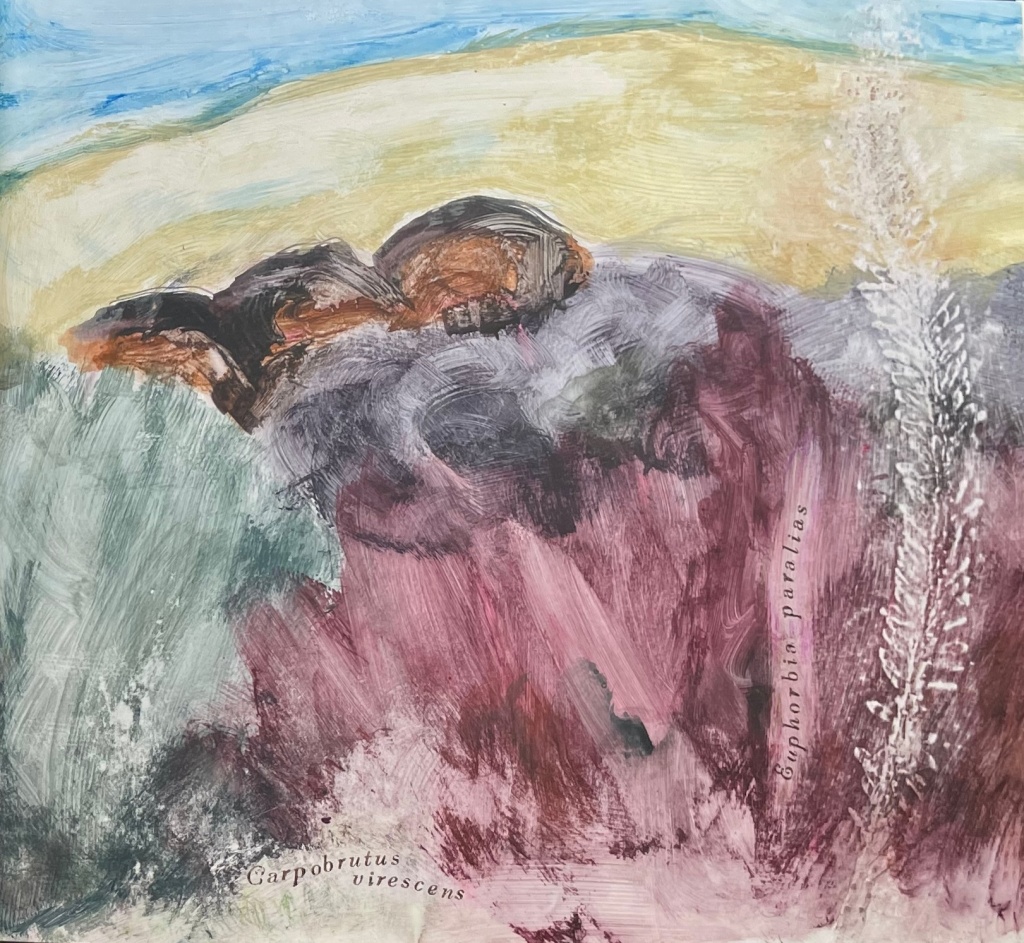
When the painted page turns, the strandline shows through the reverse and carries over into the torn edge of the white cotton paper on the right. Is that edge the crest of a white sand dune with a dark blue ocean in the background? Or is it the crest of a breaker crashing down the recto page?

When the torn-leaf is turned to the left, it does become a dune over which the debossed Sea Spurge now peeks, and we are looking beyond the dune’s crest into a cloudy white sky. The revealed dark blue recto page becomes something else altogether. The figurative has been abstracted. The debossed and gold-ink lines are the traces of the tideline and the dune crest.
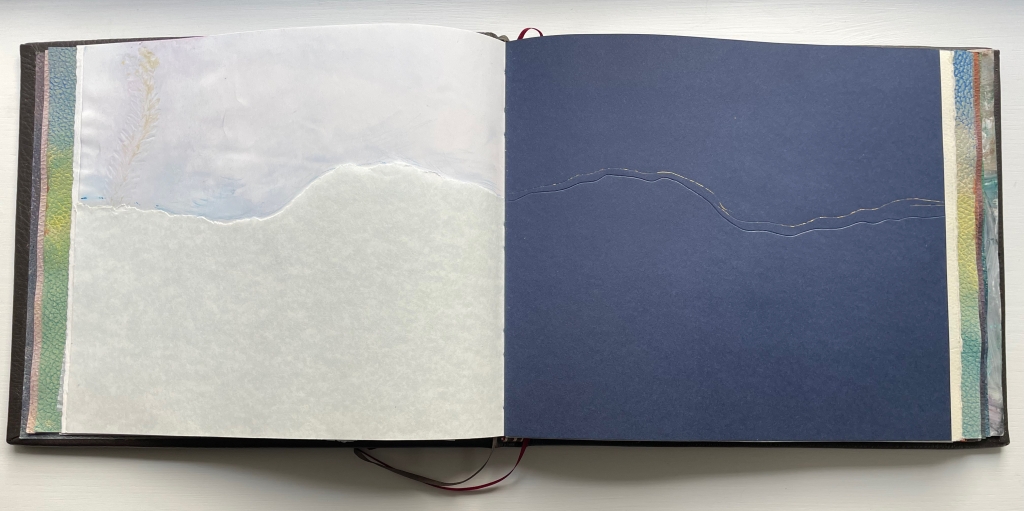
Several pages later on in the section, this is confirmed when the other half of the dark blue sheet appears with new tracery labeled “tidelines” and “shifting dunes” in black ink and initiates a new sequence ending with another painting that looks at the earlier scene from a new perspective.
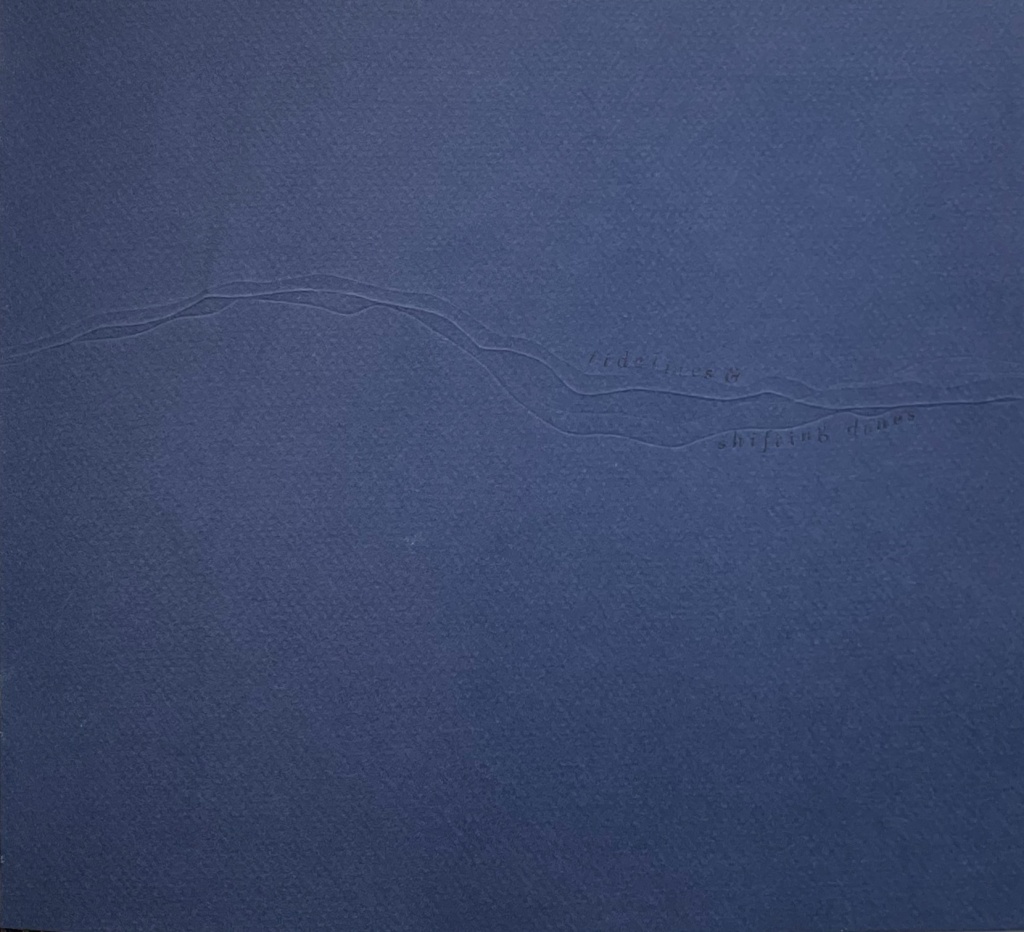
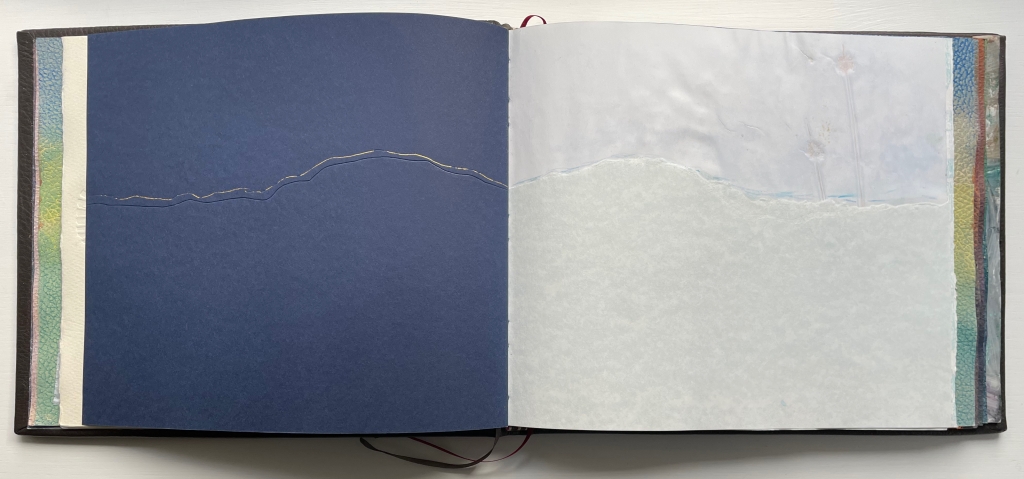

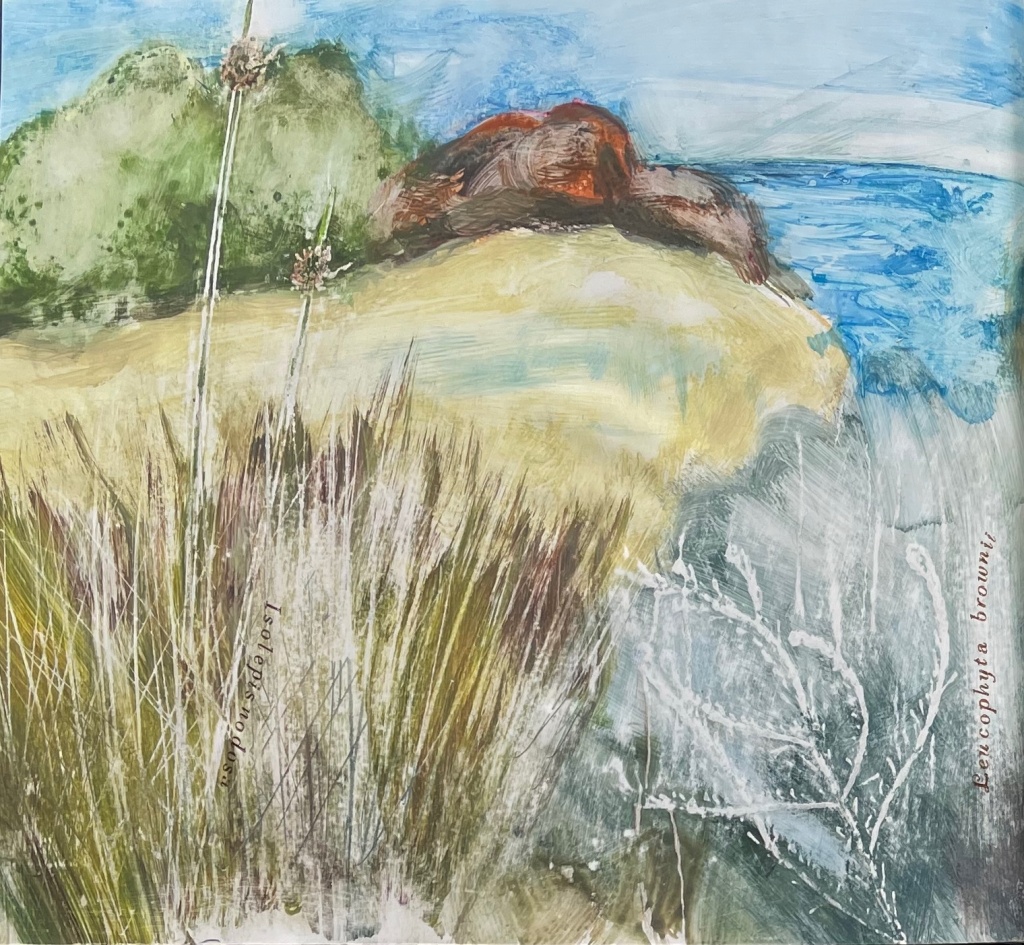
This magic as the recto page turns to verso is performed in many different ways. From “Thicket & Forest”, strips of paper woven into a sheet present one image on the recto and another on the verso.
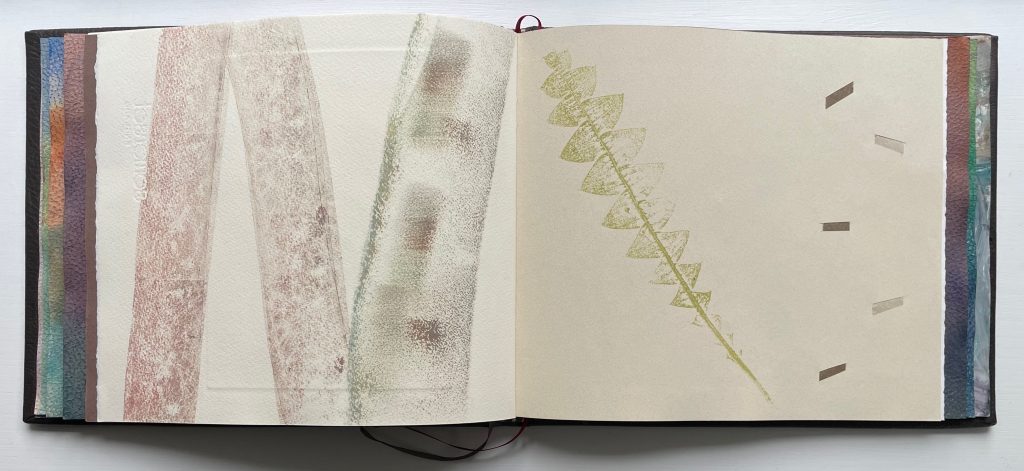
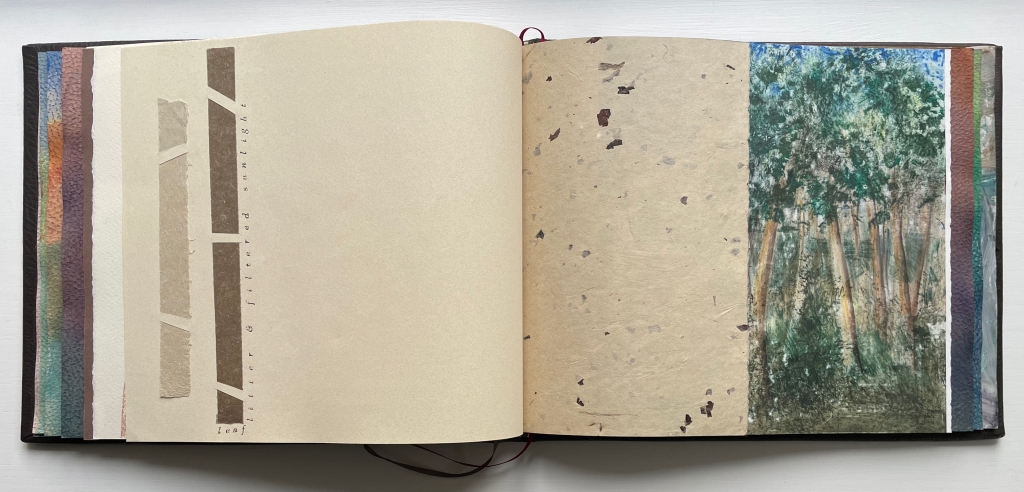
From “Coasts & Dunes” again, the simple turning of a passe partout and other cutouts transform the images preceding and those previously framed or masked. The blue and brown pattern in the square of marbled paper (suminagashi from the Awagami factory in Japan) evokes tidelines and strandlines while the layers on the right suggest fish, eels or seaweed rippling under dark green water. When the first layer from the right (the passe partout) turns left, the suminagashi sample becomes a framed print, and the image on the right grows into a larger expanse of green water. When the next layer (the fish or grass cutouts) turns, the green water is replaced with blue, the cutouts become whitecaps or porpoises breaking the surface, and, on the right, the letters tumble in a wash from left to right.
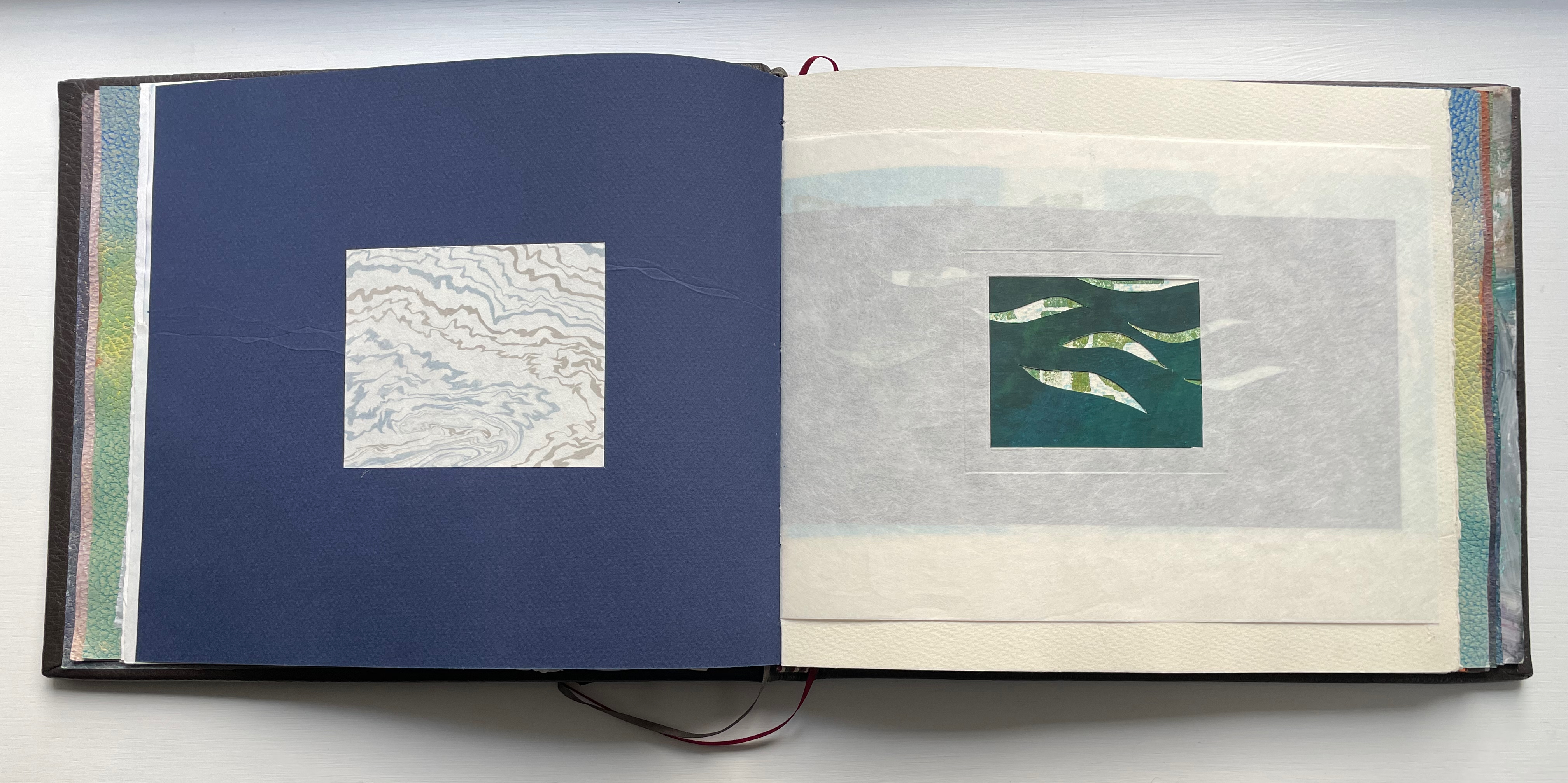

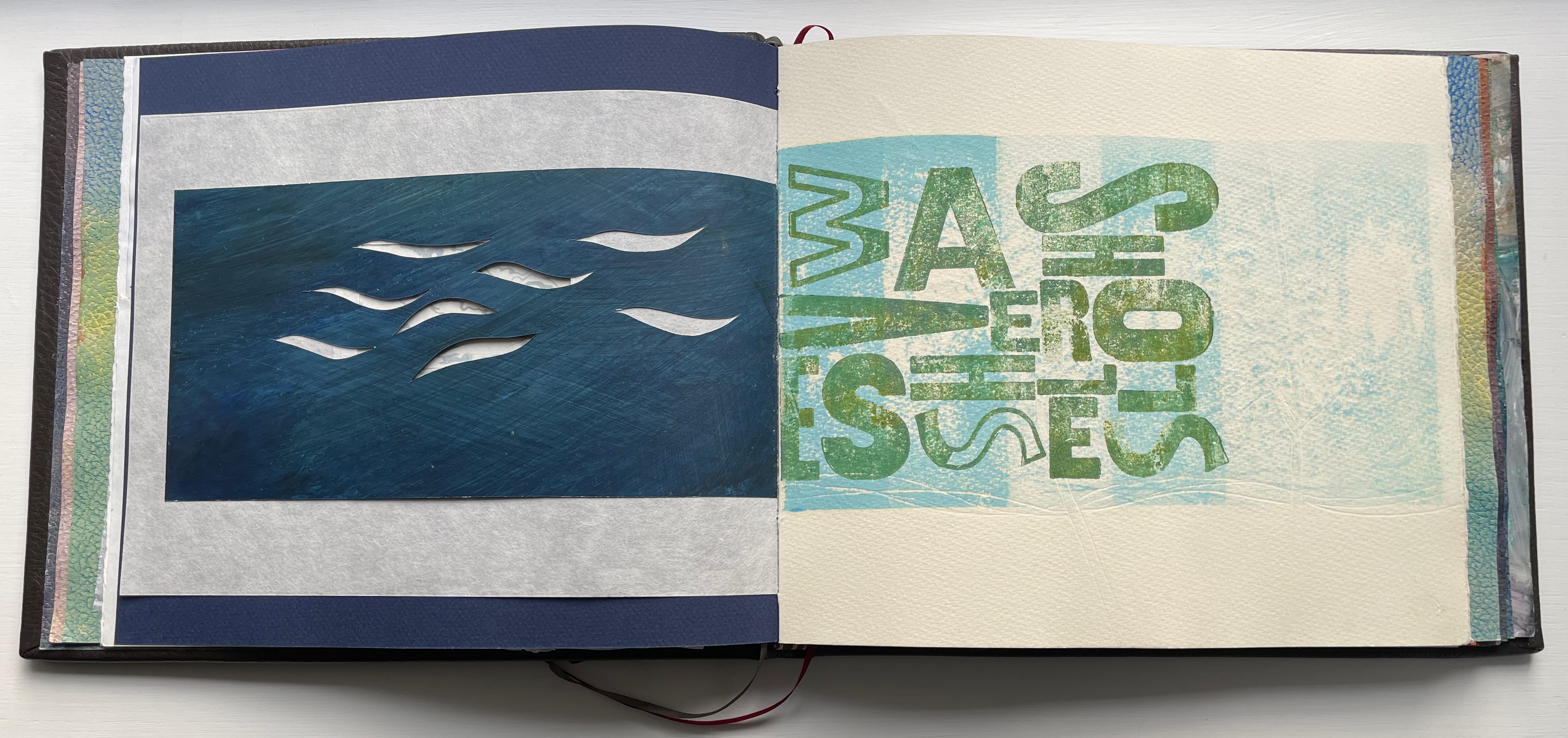
Moving through Handscapes is like a walk through an open-air gallery. You see the art with your ears as well your eyes and hands. Some Australian composer should offer to be the artists’ Moussorgsky to this exhibition. Anne Moeglin-Delcroix’s Ambulo Ergo Sum (2015), however, makes a more interesting foil for appreciating Handscapes than Moussorgsky’s Pictures at an Exhibition.

Addressing several works by three other celebrants of nature — Hamish Fulton, Richard Long and herman de vries — Moeglin-Delcroix concludes her essay neatly:
The three artists studied here through some of their books offer three ways of coming closer to the experience of nature unfiltered by the artistic tradition: nature as experienced, felt. In this process of deconditioning, walking plays a vital role: it enables them to overcome the limitations of a visual and cultural experience, involving the whole body in contact with nature itself. The artists examined here replace the “point of view” presupposed by all landscape and the conventions of artistic representation with the more neutral and more objective approaches of the collection and the inventory, as if seeking to efface themselves before nature itself. That these approaches are governed by protocols, though summary, or reintroduce the mediation of an explicit or implicit method is not inconsistent with the quest for a more immediate relationship with nature. It is that, like automatism among the Surrealists or (a reference much more familiar to these artists) emptiness in Buddhism, the immediacy or evidence lost requires, in order to be regained, self-discipline, even an asceticism of subjectivity: discipline and asceticism are visible in how their books are constructed. P. 30.
From their title onwards, Coy and Bolton are very much filtering nature through their art. Nature does not seem any less experienced or felt. It is experienced and felt through the variety of their art. And vice versa: nature filters their art. As Coy describes it in her correspondence. “We started every individual section by (sitting, walking, talking) immersing ourselves in a specific environ, taking photos and collecting plants, then back to my studio and the project’s visual diary.”
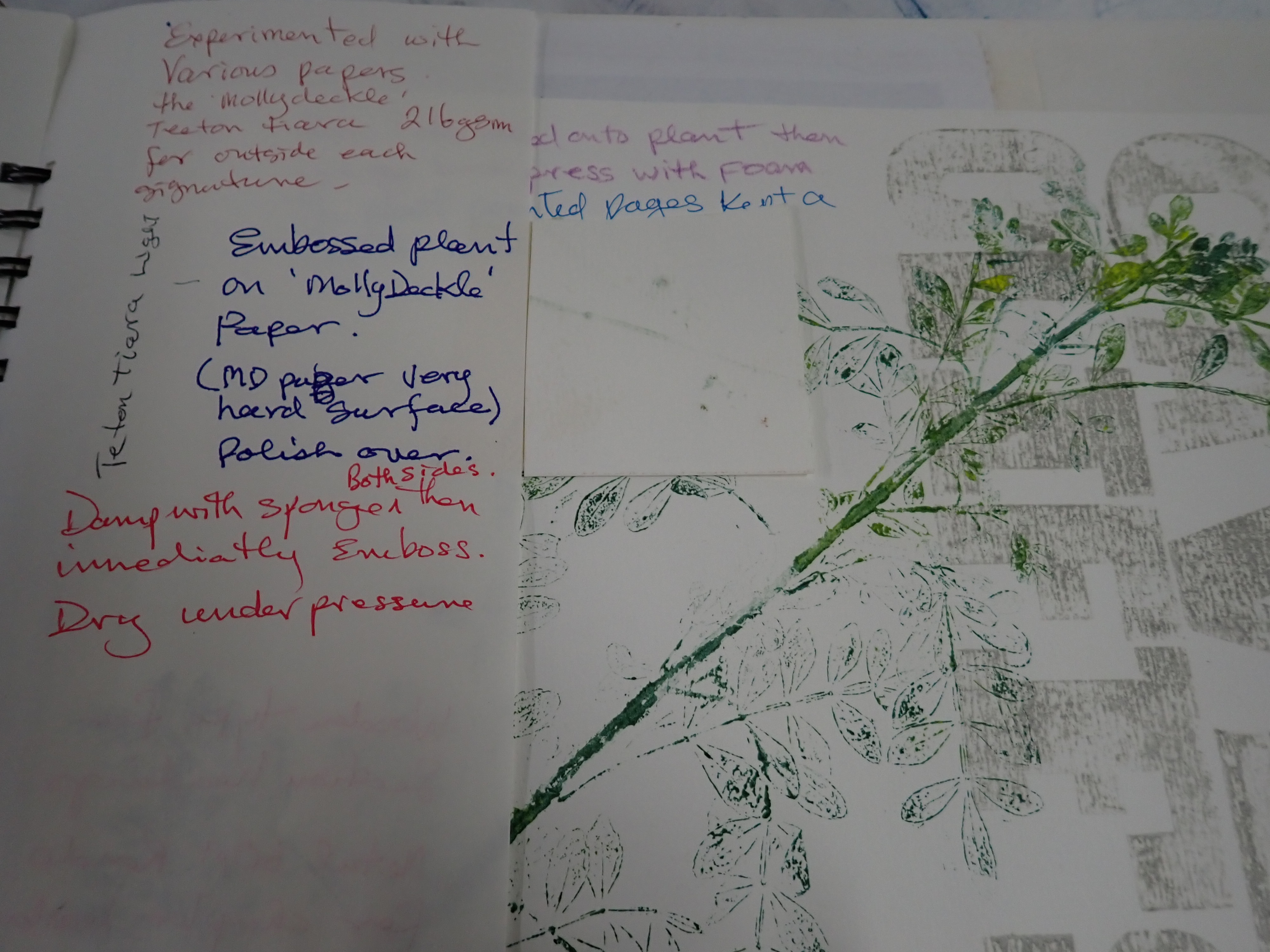
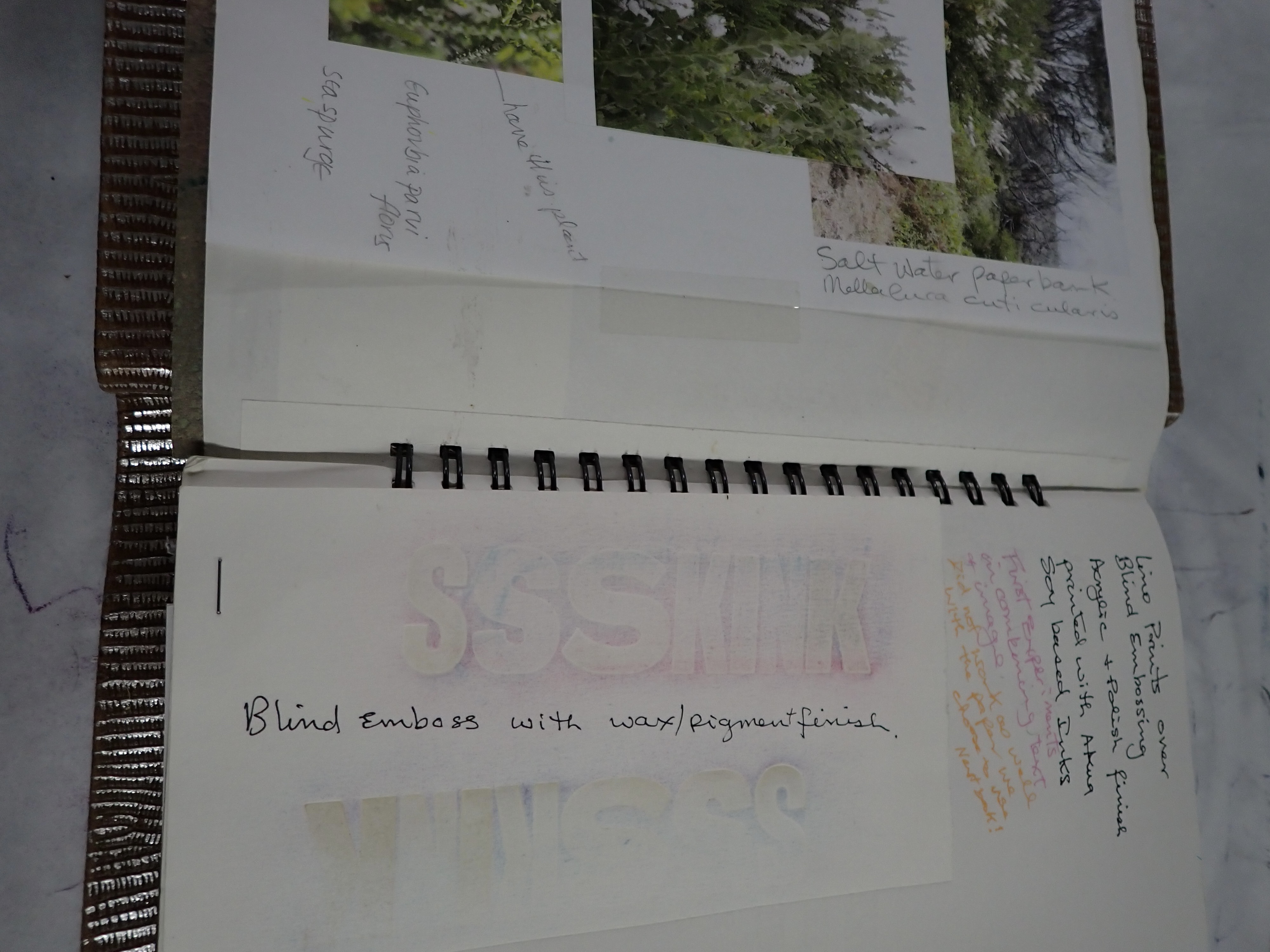
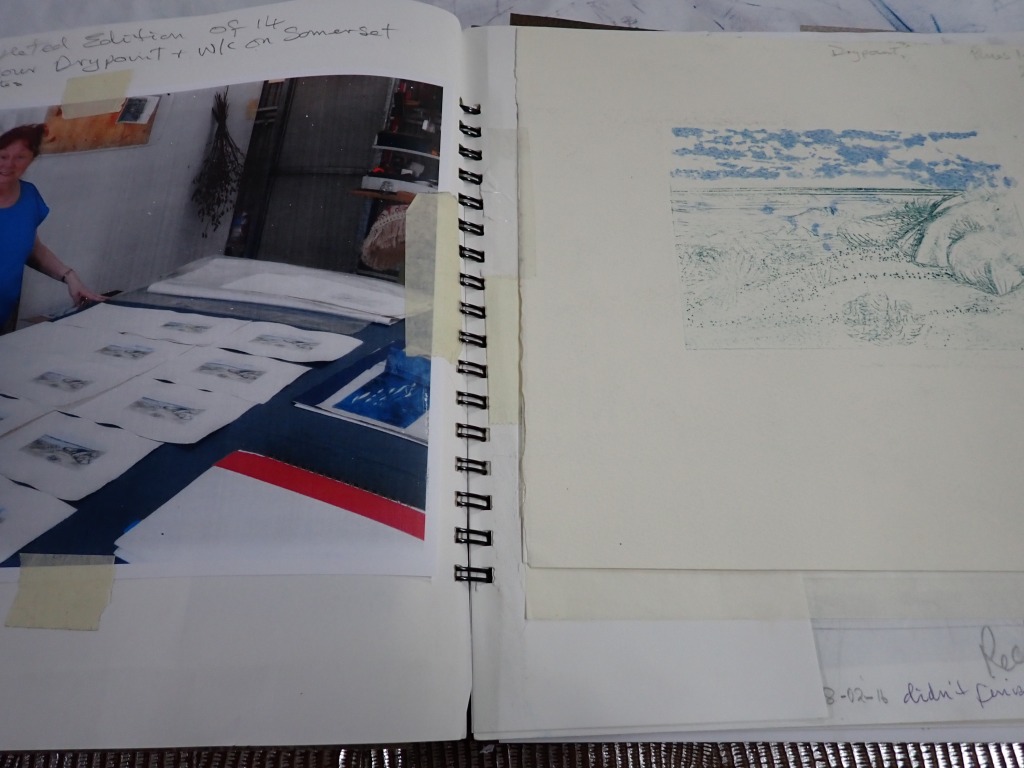

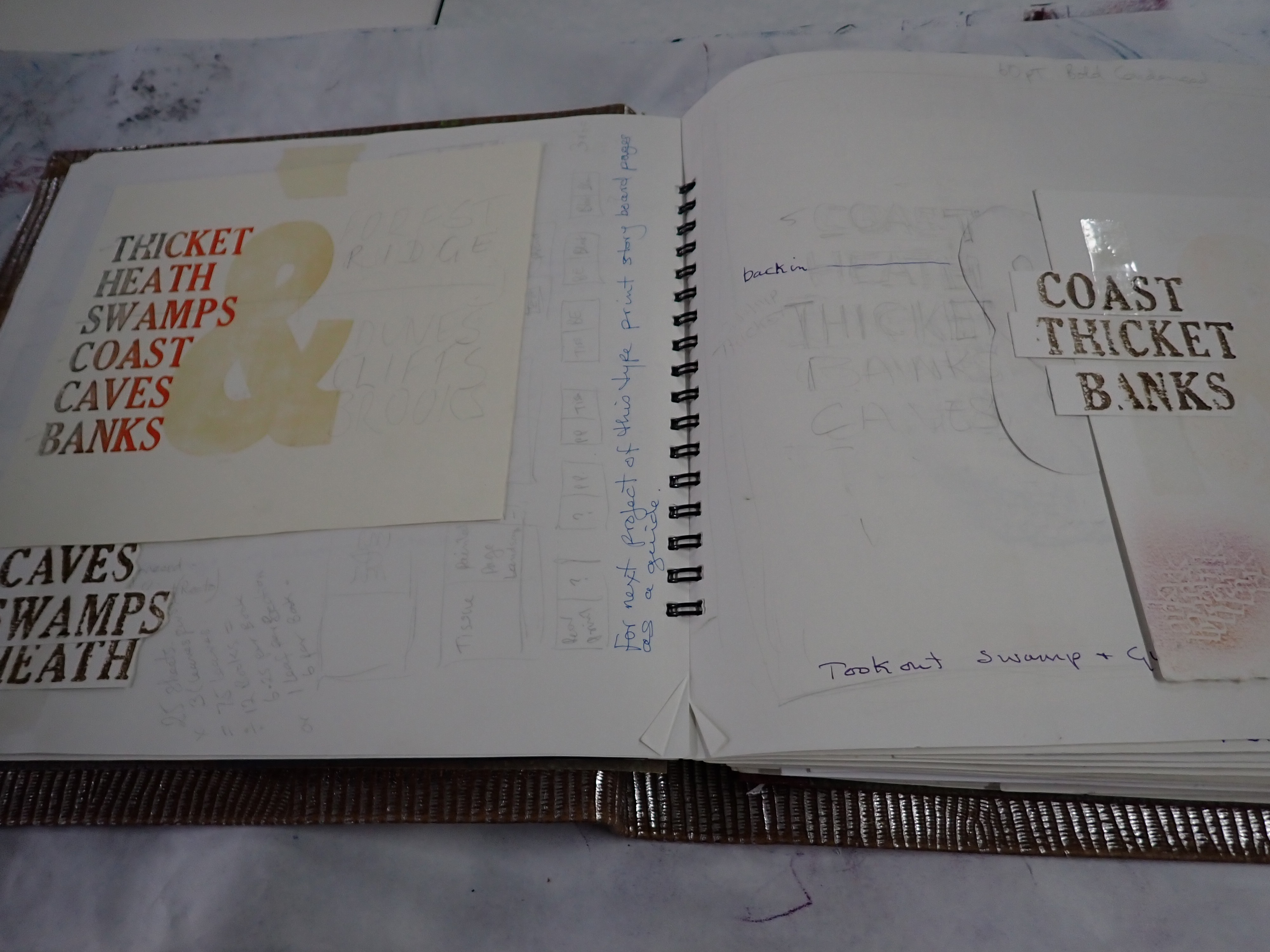
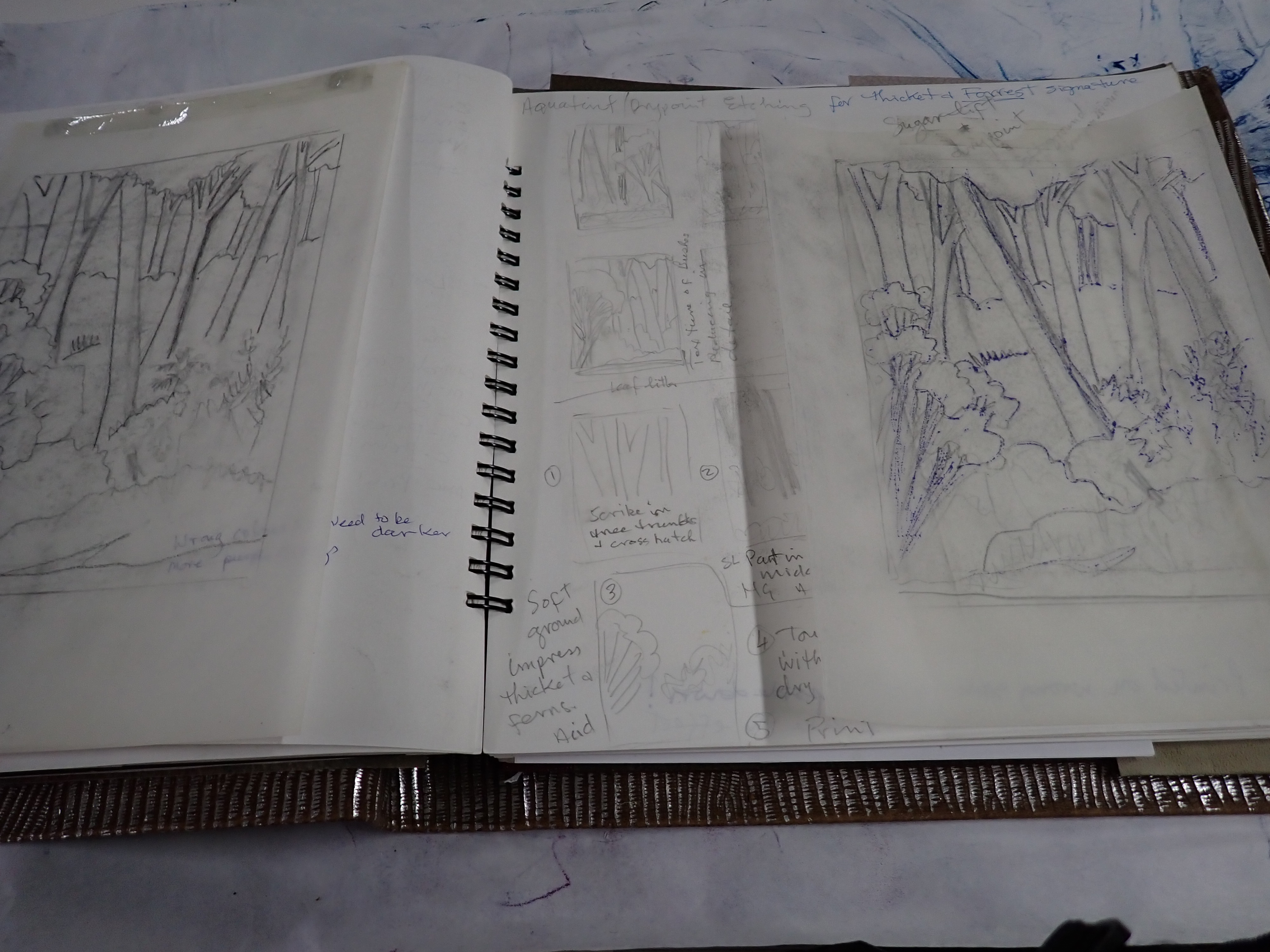
For Handscapes, collection and inventory as an approach apply as much to the Coy’s and Bolton’s conventions, tools, techniques and materials of artistic representation as they do to nature itself. They throw their art into nature, and nature into their art. Look at the vegetal detritus in the papers. Look at the leaf prints. Look at the play with perspective — from the landscape point of view to the underfoot point of view. There’s little self-effacement before nature here. As the page-turning magic demonstrates, there’s a profusion of perspectives, colors, shapes, textures and techniques — as if to celebrate the profusion of nature.
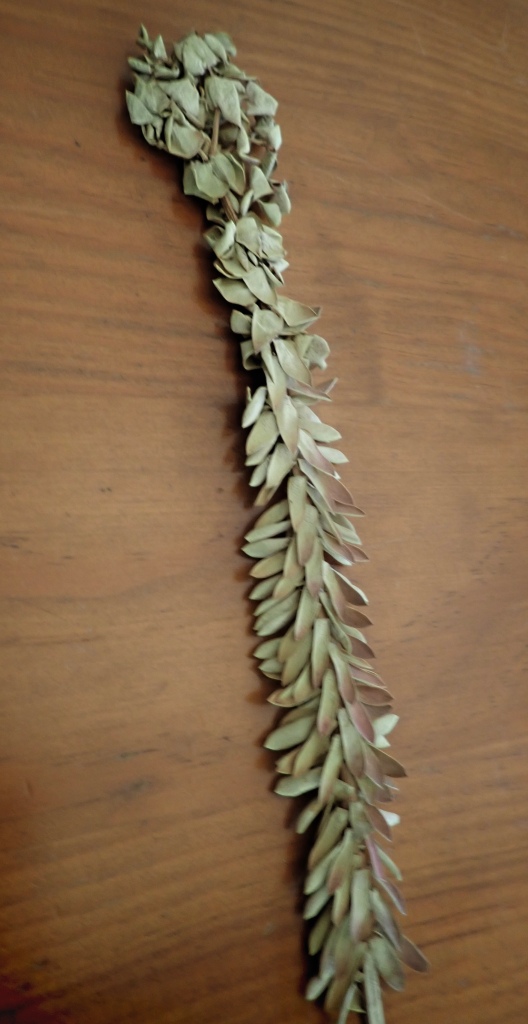
Dried specimen of Sea Spurge (Euphorbia paralis) used for Handscapes. Photo: Courtesy of Molly Coy.
This is not to place Fulton, Long, de vries, Coy and Bolton in some sort of hierarchy. Rather it is to draw attention to differences in quests to express a relationship with nature and art. And to appreciate how Coy’s and Bolton’s approach is visible in how their book is constructed.
Further Reading
“Claire Bolton“. 27 January 2024. Books On Books Collection.
“Helen Douglas“. 24 February 2020. Books On Books Collection. The work of Helen Douglas offers another interesting foil to Handscapes and Fulton, Long and de vries. Like Bolton and Coy, she draws our attention to the paper, handcraft and techniques used. Like Fulton, Long and de vries, she leans on photographic representation. Yet her works’ proximity to nature differs from that of the others. A topic worth closer study or even an exhibition.
“Helen Douglas“. 3 February 2015. Bookmarking Book Art.
“Shona Grant“. 20 October 2019. Books On Books Collection. Shona Grant’s works provide additional candidates for an extended study or exhibition on artists’ books and their representation of, and interaction with, nature.
Moeglin-Delcroix, Anne. 2015. Ambulo Ergo Sum: Nature as Experience in Artists’ Books. Buchhandlung Walther König.
